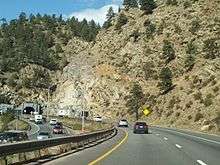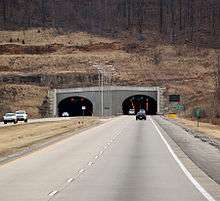Interstate Highway standards


Standards for Interstate Highways in the United States are defined by the American Association of State Highway and Transportation Officials (AASHTO) in the publication A Policy on Design Standards: Interstate System. For a certain highway to be considered an Interstate Highway, it must meet these construction requirements or obtain a waiver from the Federal Highway Administration.
Standards





These standards are, as of July 2007, as follows:
- Controlled access: All access onto and off the roadway is to be controlled with interchanges and grade separations (including railroad crossings). See List of gaps in Interstate Highways for the few cases that violate this rule. Interchanges should provide full access; ramps are to be designed with the appropriate standards in mind. Minimum interchange spacing should be 1 mi (1.6 km) in urban areas and 3 mi (4.8 km) in rural areas; collector/distributor roads or other configurations that reduce weaving can be used in urban areas to shorten this distance.
- Access control (from adjacent properties) should extend at least 100 feet (30 m) in urban areas and 300 feet (91 m) in rural areas in each direction along the crossroad from the ramps.
- Minimum design speed: In rural areas, a minimum design speed of 70 mph (115 km/h) should be used, with 50–60 mph (80–95 km/h) acceptable in rolling terrain, and as low as 50 mph (80 km/h) allowed in mountainous and urban areas.[1] Speed limits as low as 40 mph (65 km/h) are, however, occasionally encountered and generally assigned to pre-existing freeways that were grandfathered into the system.
- Sight distance, curvature and superelevation according to the current edition of AASHTO's A Policy on Geometric Design of Highways and Streets for the design speed.[1]
- Maximum grade: Maximum grade is determined by a design table based on terrain and design speeds,[1] with up to 6% generally allowed in mountainous areas and hilly urban areas with exceptions for up to 7% grades on mountainous roads with speed limits below 60 mph (95 km/h).
- Minimum number of lanes: At least two lanes in each direction, and more if necessary for an acceptable level of service in the design year, according to the current edition of AASHTO's A Policy on Geometric Design of Highways and Streets. Climbing lanes and emergency escape ramps should be provided where appropriate. Brief one-lane ramps that either "deviate" off of multi-lane freeways to connect and merge with another freeway (or one-lane bottlenecks for less than a mile before another merging freeway) are exempt from this requirement, these exceptions are mostly in rural areas.
- Minimum lane width: Minimum lane width of 12 feet (3.7 m). Also for most US and state highways.
- Shoulder width: Minimum outside paved shoulder width of 10 feet (3.0 m) and inside shoulder width of 4 feet (1.2 m). With three or more lanes in each direction, the inside paved shoulder should be at least 10 feet (3.0 m) wide. If truck traffic is over 250 Directional Design Hour Volume, shoulders at least 12 feet (3.7 m) wide should be considered. In mountainous terrain, 8 feet (2.4 m) outside and 4 feet (1.2 m) inside shoulders are acceptable, except when there are at least four lanes in each direction, in which case the inside shoulders should also be 8 feet (2.4 m) wide.
- Pavement sloping: Pavement cross slope of at least 1.5% and preferably 2% to ensure proper drainage on flat sections. This can be increased to 2.5% in areas of heavy rainfall. Shoulder cross slope should be between 2% and 6% but not less than the main lanes.
- Land slopes within the clear zone should be at most 4:1 and preferably 6:1 or flatter. Roadside barriers should be used for slopes of 3:1 or steeper, in accordance with the current edition of AASHTO's Roadside Design Guide.
- Median width: Minimum median width of 36 feet (11 m) in rural areas, and 10 feet (3.0 m) in urban or mountainous areas. To prevent median-crossing accidents, guard rail or Jersey barrier should be installed in medians in accordance with the current edition of AASHTO's Roadside Design Guide, based on traffic, median width and crash history. When possible, median openings between parallel bridges less than 30 feet (9.1 m) in width should be decked over; otherwise barriers or guard rails should be installed to exclude vehicles from the gap. Recently, cable median barriers are being installed on busier Interstate Highways in rural areas regardless of median width.
- Recovery areas: No fixed objects should be in the clear recovery area, determined by the design speed in accordance with the current edition of AASHTO's Roadside Design Guide. When this is not possible, breakaway supports or barriers guarding the objects shall be used.
- Curb slope: Vertical curbs are prohibited. Sloping curbs are to be at the edge of the paved shoulder, with a maximum height of 100 millimetres (3.9 in). The combination of curbs and guard rail is discouraged; in this case the guard rail should be closer to the road than the curb.
- Vertical clearance: Minimum vertical clearance under overhead structures (including over the paved shoulders) of 16 feet (4.9 m) in rural areas and 14 feet (4.3 m) in urban areas, with allowance for extra layers of pavement. Through urban areas at least one routing should have 16-foot (4.9 m) clearances. Sign supports and pedestrian overpasses must be at least 17 feet (5.2 m) above the road, except on urban routes with lesser clearance, where they should be at least 1 foot (30 cm) higher than other objects.
- Horizontal clearance: under or along a bridge shall be the full paved width of the rest of the road. Bridges longer than 200 feet (61 m) can be narrower, with a minimum of 4 feet (1.2 m) on both sides of the travel lanes.
- Bridge strength: New bridges are to have at least MS 18 (HS-20) structural capacity. Weaker bridges that can continue to serve the route for 20 more years are allowed to remain.
- Additionally, existing bridges can remain if they have at least 12-foot-wide (3.7 m) lanes with 10-foot (3.0 m) outside and 3.5-foot (1.1 m) inside shoulders. Long bridges are to have at least 3.5 feet (1.1 m) on each side of the travel lanes; bridge railing should be upgraded to current standards if necessary.
- Tunnel clearance: Tunnels should in theory be equivalent to long overcrossings, but because of cost the standards can be reduced. Vertical clearance is the same as under bridges, including the provision for alternate routing. Width should be at least 44 feet (13 m), which consists of two 12-foot-wide (3.7 m) lanes, 10-foot (3.0 m) outside and 5-foot (1.5 m) inside shoulders, and 2.5-foot (76 cm) safety walkways on each side. If necessary to meet the dimensions of the approach, this can be shifted left or right. A reduced width is acceptable due to high cost. In this case, the minimum width is 30 feet (9.1 m), with at least 2 feet (61 cm) more than the approach for the sum of the shoulder widths, but at least 24 feet (7.3 m) total, and at least 1.5 feet (46 cm) on each side for a safety walkway. If there is no safety walkway, a 3-foot (91 cm) offset with a "safety shape" in the wall is acceptable.
Exceptions

The standards have been changed over the years, resulting in many older Interstates not conforming to the current standards, and yet others are not built to standards because to do so would be too costly or environmentally unsound.

Some roads were grandfathered into the system. Most of these were toll roads that were built before the Interstate system came into existence or were under construction at the time President Dwight D. Eisenhower signed the Federal Aid Highway Act of 1956. The most notable example is the Pennsylvania Turnpike, which originally had a very narrow median that later required the installation of a Jersey barrier due to heavy traffic loads.
Interstate 35E through St. Paul, Minnesota is an example of a freeway that was not grandfathered into the system that is nonetheless an exception to standards. The freeway was not opened until 1990, has a speed limit of 45 mph (70 km/h), and does not allow vehicles weighing over 9,000 pounds (4,100 kg) GVW. This is due to a number of lawsuits from wealthy surrounding homeowners, which heavily delayed and modified the project dating to the 1960s.
Interstate 75 on the Mackinac Bridge between St. Ignace and Mackinaw City, Michigan, is undivided. The bridge was designed before the start of the Interstate Highway System, and it was grandfathered into the system.[3]
Interstate 93 through Franconia Notch, New Hampshire is also a notable exception being a super two parkway with a speed limit of 45 mph (70 km/h).
All the unsigned Interstates in Alaska and Puerto Rico are exempt from Interstate Highway standards and are instead, per Title 23, Chapter 1, Section 103 of the U.S. Code, "designed in accordance with such geometric and construction standards as are adequate for current and probable future traffic demands and the needs of the locality of the highway".[4]
References
- 1 2 3 Staff (2001). A Policy on Geometric Design of Highways and Streets (PDF) (4th ed.). Washington, DC: American Association of State Highway and Transportation Officials. pp. 507 (design speed), 510 (Exhibit 8–1: Maximum Grades for Rural and Urban Freeways). ISBN 1-56051-156-7. Retrieved April 11, 2014.
- ↑ Port Huron Transportation Service Center. "I-94/I-69 Reconstruction in St. Clair County". Michigan Department of Transportation. Retrieved July 3, 2012.
- ↑ Rubin, Lawrence A. (1985). Bridging the Straits: The Story of Mighty Mac. Detroit: Wayne State University Press. ISBN 978-0-8143-1789-1.
- ↑ United States Congress. "Title 23, Chapter 1, Section §103". U.S. Government Printing Office. Retrieved May 31, 2012.
- "Interstate standards", John Lansford, employee North Carolina Department of Transportation, misc.transport.road newsgroup November 2, 1999
External links
- Public Safety Standards, United States (Federal Government) - Offers free downloads of documents, including AASHTO's "A Policy on Design Standards", that have been incorporated by reference into the US Code of Federal Regulations and can therefore be freely copied as edicts of government.
- AASHTO Bookstore - A Policy on Design Standards - Interstate System (ISBN 1560512911)